Have you ever noticed your breast size changing when you’re stressed? I’ve been through it, and it isn’t easy. This issue isn’t talked about openly usually. But it’s important to discuss how stress affects our breasts. Let’s look into how our mental health can change the shape and size of our breasts.
My journey with changing breast sizes made me see them differently. They’re not just body parts; they show how healthy we are inside. Stress hormones react to daily stress and can affect our breasts. I want to help you understand this connection. I’ll also share tips to handle these changes with strength and kindness toward yourself.
Key Takeaways
- Stress hormones, like cortisol, influence the size and shape of breasts.
- Our emotional health and how we feel about ourselves are big factors in how our breasts develop and change.
- If our breasts are symmetrical, it shows health and attracts others. But too much difference in shape may signal health issues.
- It’s important to manage stress and make lifestyle changes for better breast health.
- Getting the right bra size and style can improve how you feel about your breasts during changes.
Let’s explore the link between stress and breast size together. I want to help you take control of your breast health. We will learn to appreciate the natural variety of women’s bodies. Join me on a journey of self-discovery and caring for our bodies with love and understanding.
Psychological Impact of Breast Asymmetry
Studies show that slight differences in breast size greatly affect how teenage girls feel about themselves. When one breast is visibly larger, it can lower a girl’s self-esteem and mood. Such issues make it hard for them to interact with others and can cause eating disorders.
Emotional Well-being and Self-esteem Affected
Girls with big breasts, like in macromastia, share similar challenges to those with breast asymmetry. It shows that breast shape matters more than just for appearances. Dealing with breast size issues can shake a girl’s confidence early on. So, getting help early is vital.
Mental Health Effects Similar to Macromastia
Experts suggest that therapy and support are crucial for girls with breast asymmetry. By recognizing the mental effects of this condition, we can offer better help. This way, young girls can overcome the emotional hurdles they face.
The Evolutionary Significance of Breast Morphology
The human breast is a topic of interest, from both evolution and culture viewpoints. They are seen as features linked to female reproductive fitness. Larger breasts can show good health and ability to care for children. This makes them appealing to potential mates.
Breast Size: A Potential Signal of Fecundity
Breast size can show a woman’s ability to have and nurture children. Imagine breasts as a signal to men: they tell if a woman is healthy and fertile. This message is pretty much the same worldwide.
Symmetry and Attractiveness in Breast Morphology
Besides size, symmetry in the breasts is also attractive. It suggests the woman is healthy and her immune system is strong. Research shows that men prefer symmetric breasts. They see this as a sign of good genes and health.
The role of breast morphology goes deep. It connects physical health, ability to have kids, and what we see as attractive. This understanding helps us see how our biological and social experiences shape our view of breasts.

Fluctuating Asymmetry and Developmental Instability
Another source talks about fluctuating asymmetry (FA). It means small, random differences from perfect similarity. These differences show if someone’s development was smooth or not. Problems like sickness, not eating well, or being exposed to harmful things can cause FA.
Stress Factors and Asymmetry during Development
Studies show that FA in parts like breasts tells us about someone’s health and ability to fight diseases. Things like stress hormones and how we think affecting breast growth might make them look different. This connects how we feel with how our bodies develop.
Associations with Health and Immunocompetence
People find those with less FA, meaning more balanced features, more appealing and healthier. This signals that someone hasn’t had the easiest path during development and might face issues with their mental health and breast health. Knowing the impact of stress control and life habits on bust size helps us take a whole-person view on breast health.
Can Stress Affect Breast Size?
The link between stress and breast size changes is very interesting. We see how stress hormones, your mind, and growth play a role. Next, we’ll look closer at how stress affects breast size.
Cortisol, the stress hormone, is a big part of this. It directly affects breast tissue. High cortisol from too much stress can change your breast’s makeup. This can make them grow or shrink. It shows how your mind and body are connected.
There’s a scientific term called fluctuating asymmetry (FA) that comes in here. FA means your body is a bit uneven, like imperfectly matched breasts. Stress can cause this. Studies show that more symmetrical breasts might mean better health and genes. So, having symmetrical breasts could make someone seem more attractive and healthy. This shows the deep link between stress, your body, and how people see you.
Understanding how stress affects your body is crucial. Knowing this helps us take care of our mental and physical health. We can use this info to improve our stress handling. And this can help keep our breasts healthy and looking good.
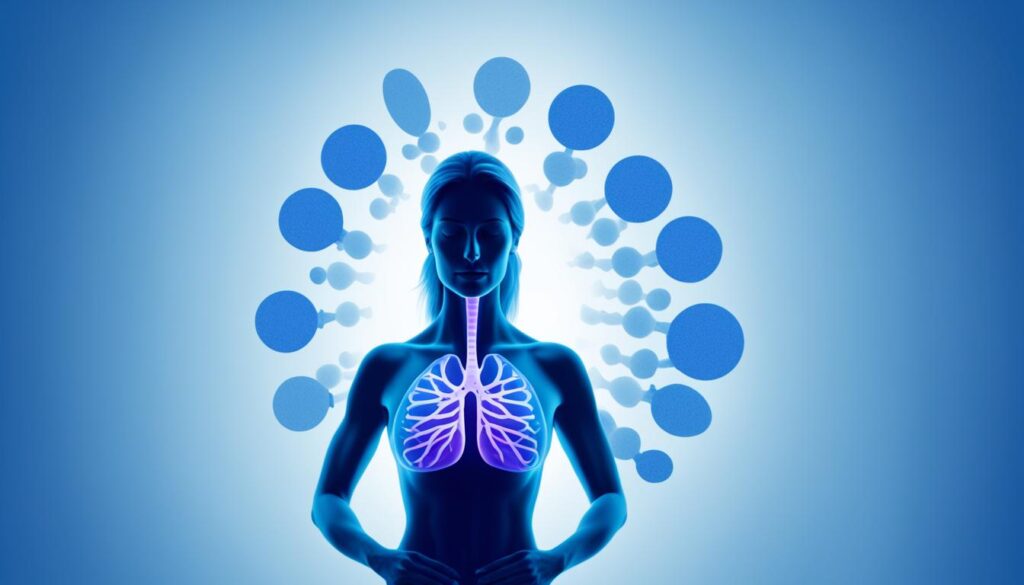
The Impact of an Ill-Fitting Bra
It’s key to know how stress, hormones, and breast size are linked. Yet, understanding the risks of wearing the wrong bra is also vital. Research shows a too-tight bra can seriously affect breast health and how you feel overall.
Chest Pain from Bra Constriction
A too-tight bra can squash your chest, which hurts. It squeezes the nerves and slows blood flow. This can lead to pain, soreness, and even make the skin irritated. It’s worse for those experiencing stress-related breast shifts or size and shape changes.
Side Effects of a Tight Bra
Wearing a tight bra for too long can cause inflammation and harm the breast tissue. This affects your breast health and wellness. It can make existing problems worse or create new ones. Knowing the dangers of a bad-fitting bra is essential for great breast size and symmetry, and for your physical and emotional health.
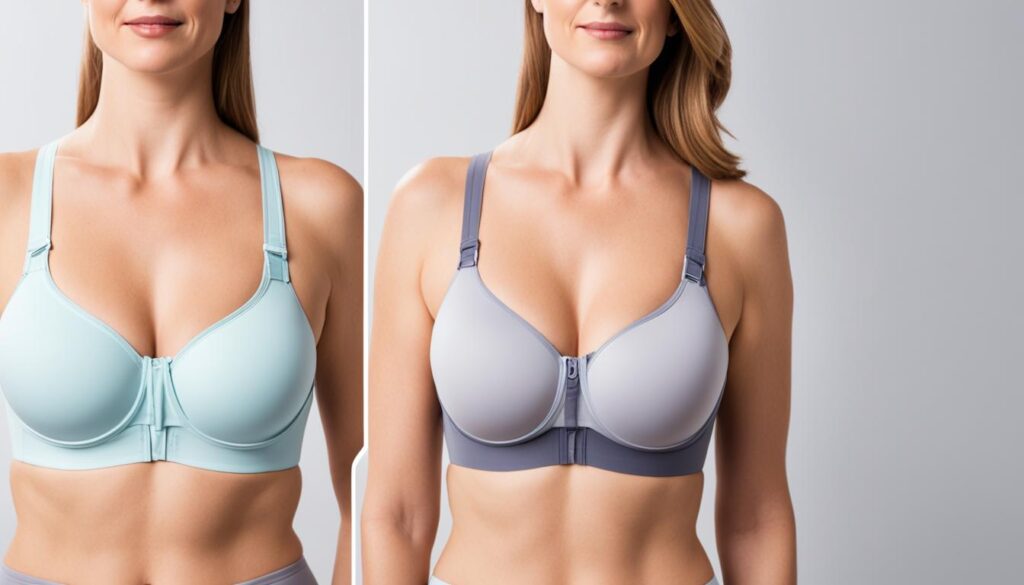
Identifying Symptoms of an Ill-Fitting Bra
Understanding how stress links to breast health is key. It’s just as vital to know the dangers of a wrong bra size. It can affect our mind and body, with stress playing a big role. It changes our hormones and breast size, showing how important this topic is.
A bra that’s too tight often leaves marks on the skin. Red lines or dents mean it’s too constricting. This also shows the deep connection between our thoughts and breast health.
Watching for such signs early and knowing the impact of lifestyle helps a lot. It prevents big problems later on. Taking care of both your emotional well-being and breast health is crucial. It’s about choosing a bra that fits and supports naturally.
| Symptom | Potential Cause | Recommended Action |
|---|---|---|
| Red marks or indentations on the skin | Bra band or straps are too tight, causing constriction | Get professionally fitted for a properly sized bra that provides adequate support without digging in |
| Straps digging into the shoulders | Bra band is not providing enough support, causing the straps to bear the weight | Explore bras with wider, more padded straps or a firmer band to distribute the weight evenly |
| Deep marks around the ribcage | Bra band is too tight, restricting normal breathing and circulation | Seek a bra with a larger, more comfortable band size that doesn’t leave visible marks |
Learning to spot the signs and how to cope with stress helps a lot. It means your bra is helping, not harming, your breast health. This is vital for your breasts’ health and comfort.

Stress Hormones and Breast Tissue Changes
Looking deeper into stress and its link to breast size, we find cortisol plays a big role. Cortisol, a stress hormone, affects how our breasts change. It’s key in this connection between stress and how our breasts grow, or sometimes shrink.
Cortisol’s Role in Breast Fluctuations
High levels of cortisol come from a lot of stress. This can directly affect our breast tissues. Research shows that cortisol messes with the hormones in our breasts. This leads to changes in size and shape.
The link between cortisol and our breasts is not simple. It involves many body systems. When stress hits, the body’s stress response starts. This involves the release of cortisol. This can lead to various changes in our breast tissues.
This knowledge helps us see how stress impacts our breasts. Knowing this, we can work on stress to keep our breasts healthy. It’s a step towards focusing on the relationship between our minds and our bodies when it comes to breast health.
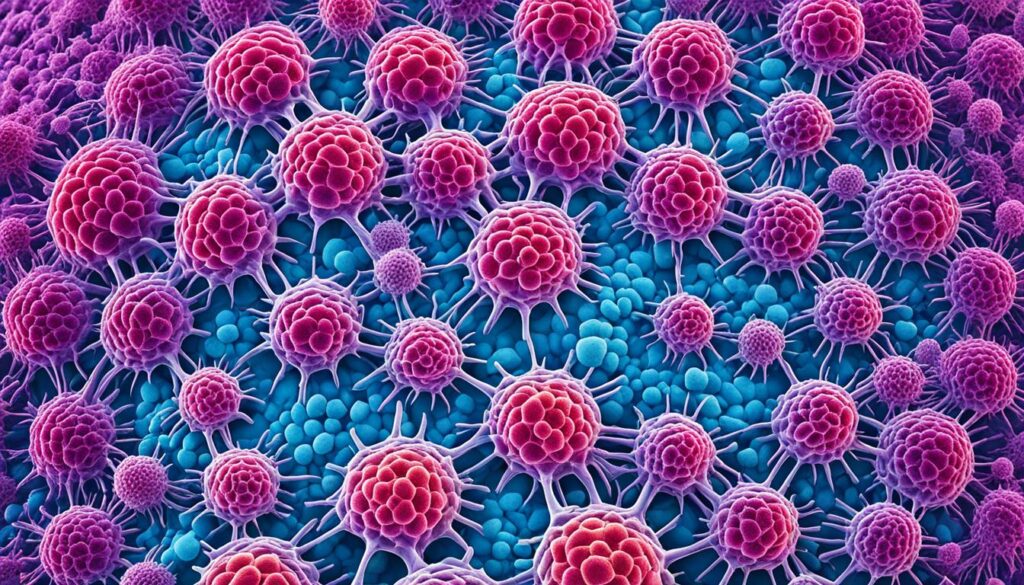
Psychological Factors Influencing Breast Development
The link between how we feel and how our bodies grow, like in breast development, is really interesting. Studies show what we think and feel, especially stress and self-esteem, can change our breasts a lot. This shows us how important it is to look at breast health in a broad way, considering both our mind and body.
Mind-Body Connection in Breast Changes
Many research works have looked at how our thoughts and feelings can shape our breast growth. A study in 2009 even linked being alone with a higher risk of breast tumors. This and other studies point out that our past experiences can affect our future breast cancer risk.
Not just stress, but how happy we are and what we think of ourselves can impact how our breasts look. Research has shown that small differences in breast size might really bother teenage girls. It shows us the need to help early. By understanding and dealing with the mental side of breast growth, we can help everyone have better breast health.
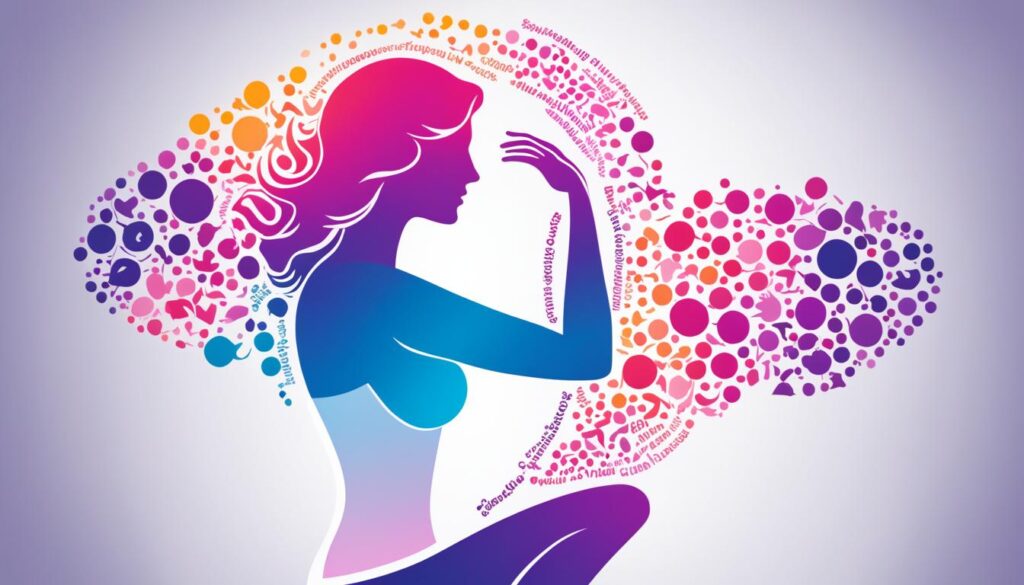
Coping Strategies for Stress-Related Breast Fluctuations
The impact of stress on breast size and shape requires a fully rounded approach. We know the mind and body are connected. This link is important for the development and care of our breasts. To keep our breasts healthy, we need to manage stress well. This means handling stress both physically and mentally.
Stress Management for Optimal Breast Health
To manage stress and its effect on our breasts, managing stress is crucial. Practices like mindfulness meditation, deep breathing, and exercise are key. They help lower stress hormones like cortisol. This way, you can keep a healthy hormonal balance and your breasts happy.
Getting professional help is also smart. A counselor or a stress coach can help you handle stress better. They help find what’s causing your stress. They teach tools for dealing with changes in your breasts with more strength.
It also helps to change a few daily habits. Focus on getting enough sleep, working out, and eating well. By looking at stress from different angles, we can reduce its bad effects on our breasts. This leads to better overall breast care.

Taking a holistic approach to breast health is critical. By using good coping methods and focusing on your well-being, you gain control. This control helps you deal with stress and keeps your breasts healthy. You deserve to feel confident and keep your breasts in good shape.
Lifestyle Factors Affecting Bust Size
Your lifestyle choices have a big say in your breast health and size. What you eat, how you exercise, and your daily habits matter a lot. The way we live can change the size and look of our breasts. Let’s see how this all works.
Eating right is key to keeping your bust in check. A diet full of fresh, nutrient-rich foods helps your breasts stay healthy. Think about adding avocados, nuts, and fish that are good for you. Avoid too much sugar and bad fats because they can mess with your hormones and affect your breast size.
Exercise is also crucial for your bust. Staying active can lower stress, which keeps your breast hormones in check. Plus, doing exercises that work your chest and upper body can make your breasts look more toned and firm.
But, it’s not just diet and exercise. Things like getting enough sleep, handling stress well, and keeping a healthy weight are important too. These factors help keep your whole body, including your breasts, in good shape. When your body is balanced, you might have a better bust line.
| Lifestyle Factor | Impact on Bust Size |
|---|---|
| Diet | Eating foods that are good for you can help your breast tissue grow healthily. But, eating too many processed foods and bad fats can throw your hormones off, changing your bust size. |
| Exercise | Staying physically active, especially with exercises that focus on your chest and upper body, can make your breasts look more lifted and defined. |
| Sleep and Stress Management | Getting enough sleep and dealing with stress in a healthy way keeps your hormones in balance. This is key for keeping your breast tissue healthy. |
To keep your breasts in good shape, look at all areas of your life. Make healthy food choices, stay active, and balance your life. This holistic approach can help you get the breast size and look you want.

Getting Professionally Fitted for the Right Bra
Having the right size bra is key for breast health. It’s important to get a professional bra fitting. A certified fitter looks at your body shape and needs. They help you find bras that fit well and feel good, boosting your confidence.
Embracing Diversity in Bra Styles
The world of bras is big and varied. You can find one that fits your personal style. From underwire to wireless, there are many options. This variety helps people feel good emotionally and keeps their breasts healthy.
For those dealing with changing breast sizes, the right bra is a game-changer. It helps handle stress and maintain a good bust size. By looking at lifestyle factors and offering solutions, this section supports a positive mind and body link.
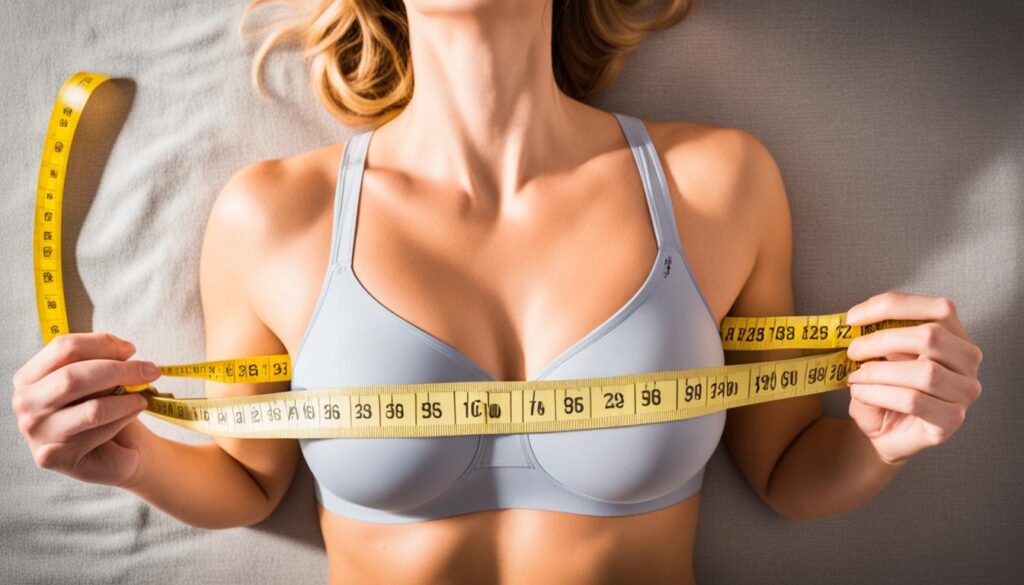
Conclusion
The link between stress and breast size is not straightforward. Hormone changes from stress, like cortisol, can affect breast size and shape. This shows how our mind and body are strongly connected when it comes to breast health.
It’s vital to take care of both our mind and body for healthy breasts. Knowing how emotions influence breast growth helps. Also, using ways to handle stress’s effects on breasts can make a big difference.
Choosing the right bra style and getting a proper fitting is also important. This ensures your breasts are well-supported and comfortable. It can help with any everyday things that impact your bust size.
Taking a wholistic approach to breast health is best. Managing stress and wearing bras that fit you well are key. Seeing the link between our feelings and physical health is crucial. It’s about moving towards a balanced journey of breast wellness.
